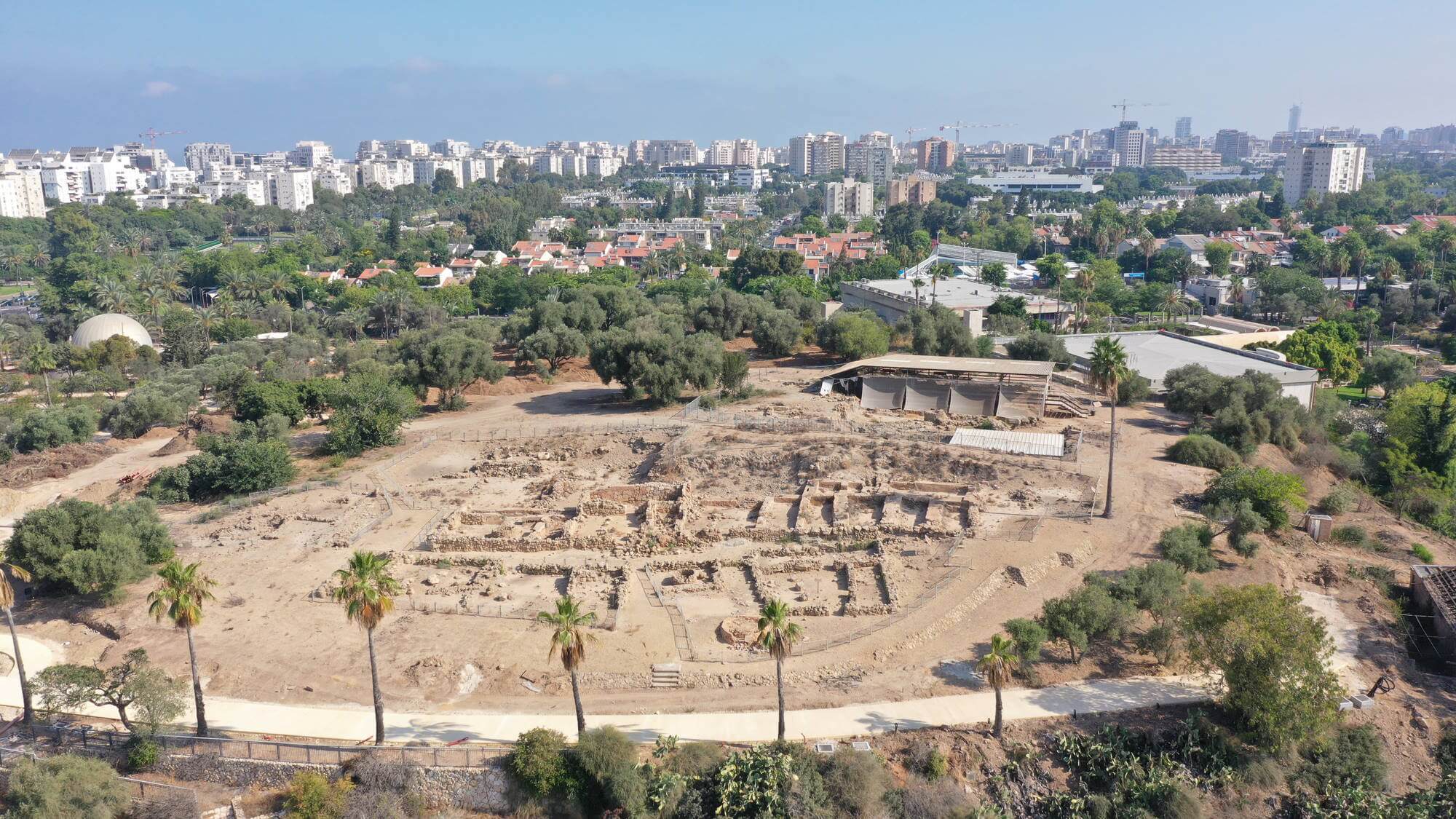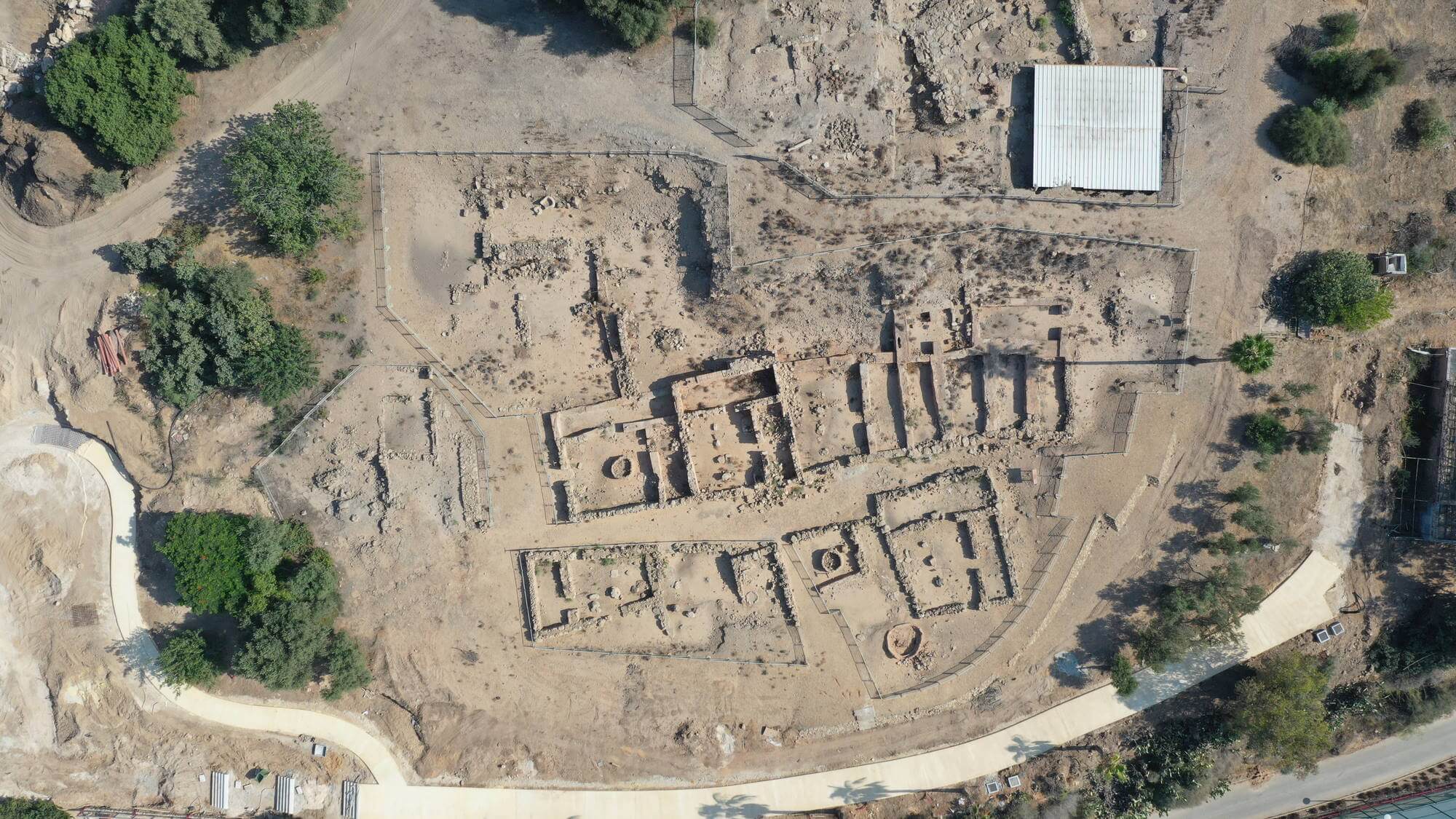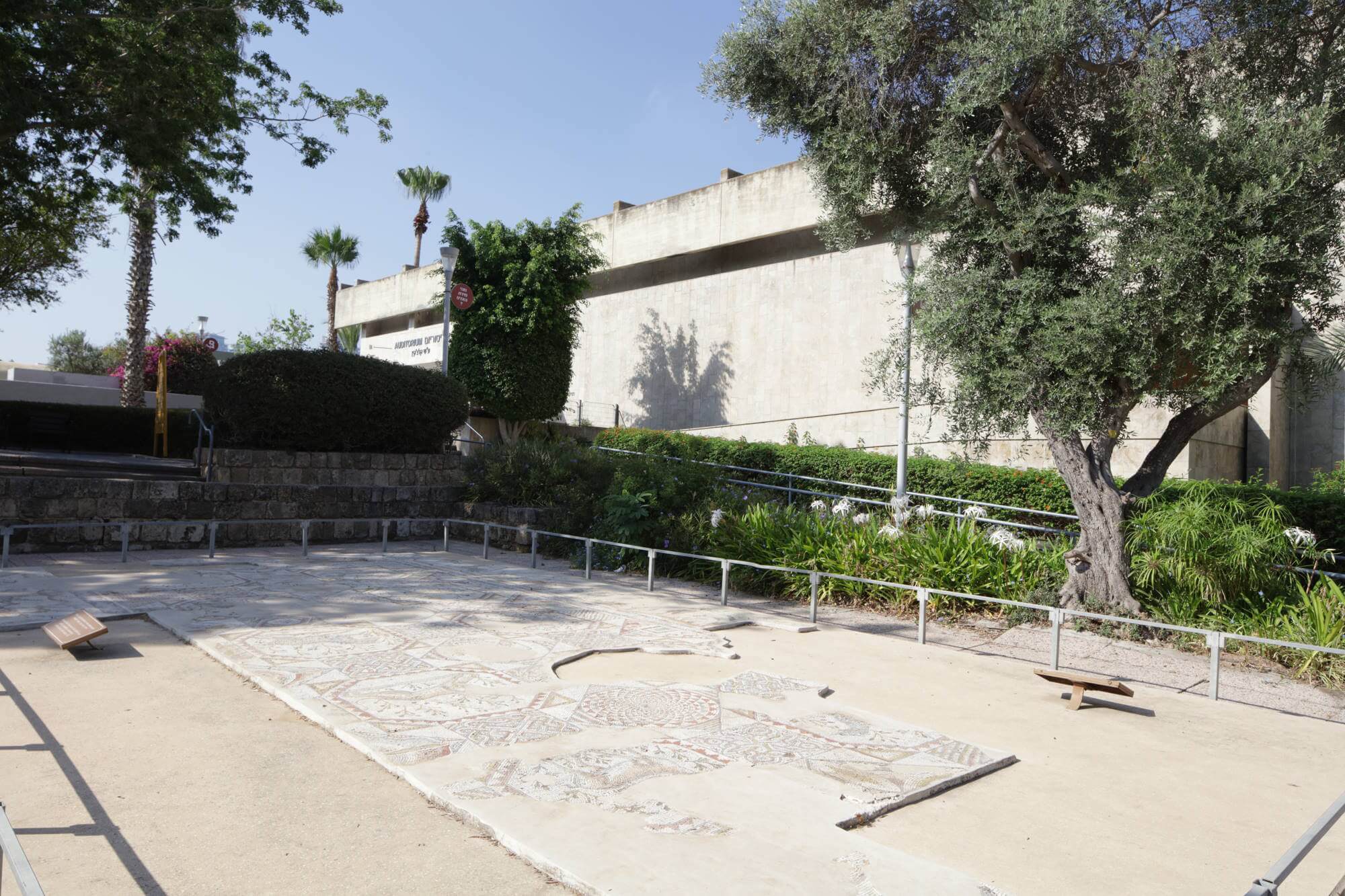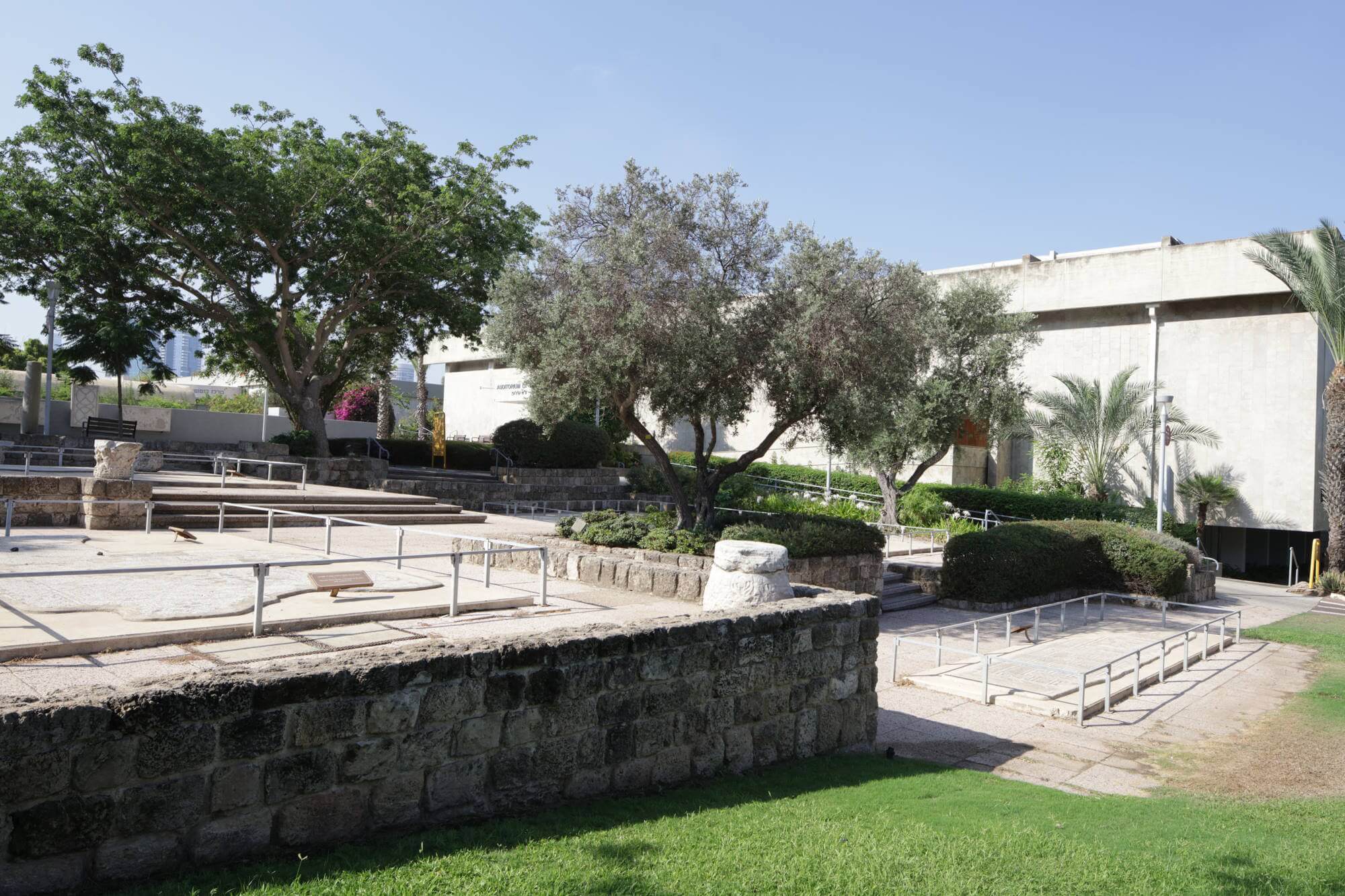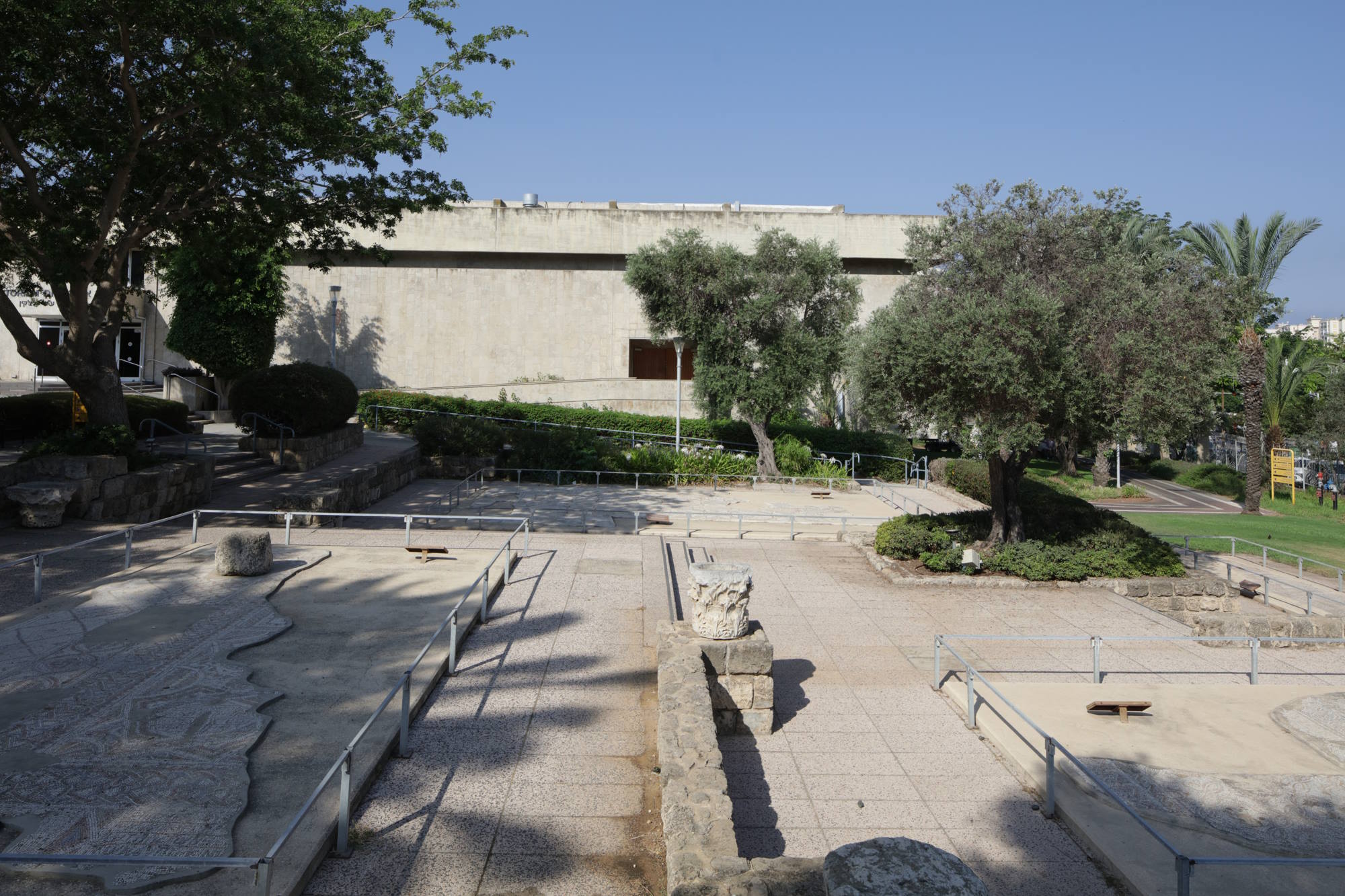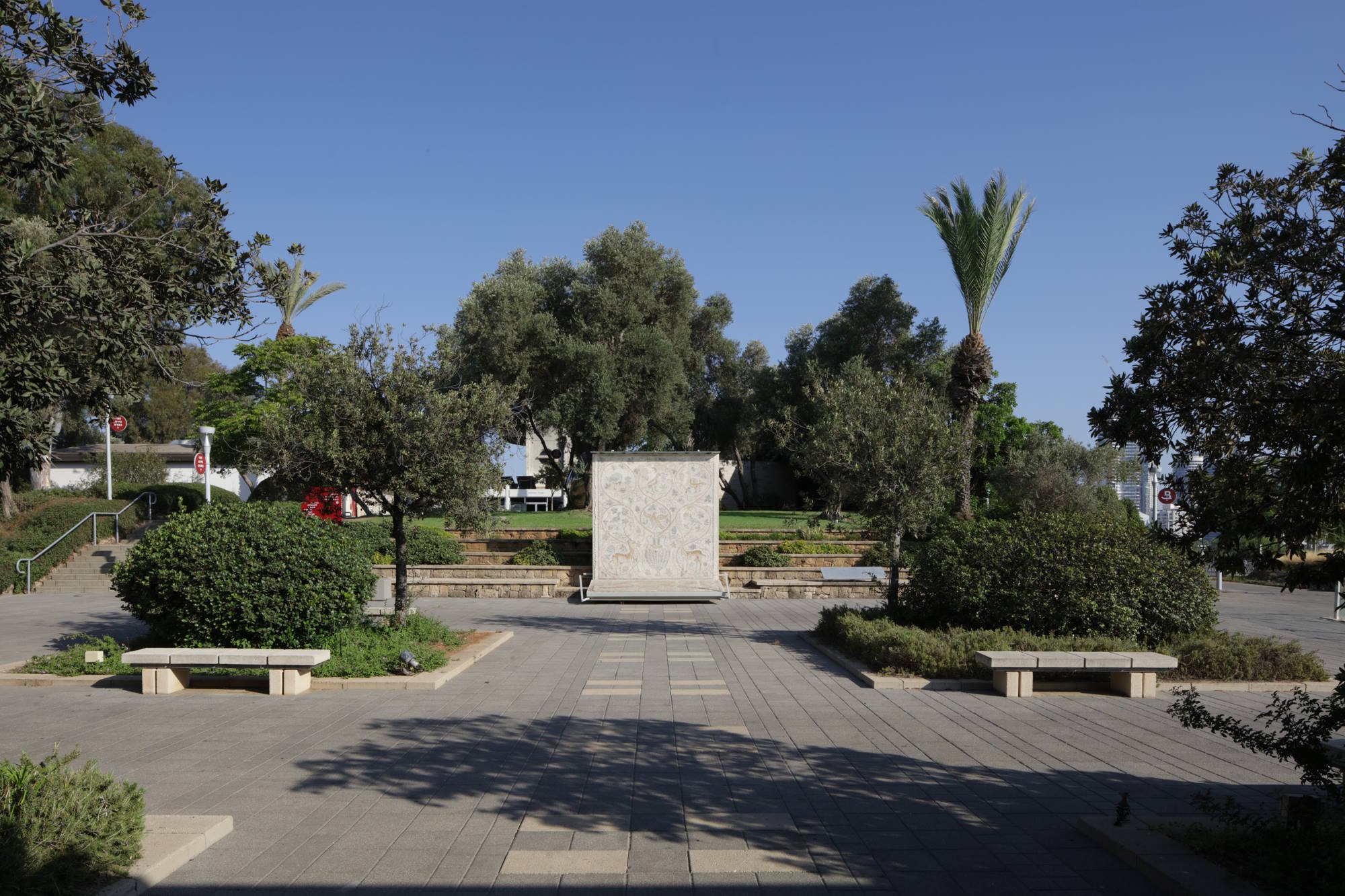The grounds of MUZA – Eretz Israel Museum, Tel Aviv, offer the visitor the opportunity to take a stroll through nature without leaving the city. Located in the western part of the Museum is a spacious Israeli park, centered around a pond and an important and fascinating tell. Other archaeological exhibits from all over the country are scattered around the museum, including stunning ancient mosaics, a reconstructed olive press and flour mill, and the Sundial Square.
Tell Qasile
High at the heart of the Museum stands Tell Qasile, one of the most fascinating and important archaeological sites excavated in Israel, containing remains of an ancient settlement going back more than 3,000 years.
In the 1940s two potsherds (ostraca) were discovered on the surface of the tell bearing Hebrew inscriptions from the First Temple period. These ostraca attracted great interest and after their discovery, in 1948, the newly-established State of Israel’s first excavation permit was issued for the site. The initial excavations, which continued at intervals from the 1970s to the early 1990s, where headed by Professor Benjamin Maisler (Mazar), followed by Professor Amihai Mazar. During the excavations twelve layers of ancient settlement were discovered at the site containing evidence for a small community over 3,000 years old, carefully planned and buzzing with activity during the 150 years of its existence.
At the top of the tell the settlement’s sacred complex was discovered, including the remains of three temples built one on top of another. The temples were built from sun-dried clay bricks covered in plaster, with low benches built along them. Many offering and ritual vessels were discovered within the temple, including rare and unique items, some of which are on display to visitors in the Ceramics Pavilion. Close to the central temple a smaller temple was uncovered, which may have been for the priest’s personal use or devoted to the worship of another god, secondary in importance. In the temple courtyard an altar was discovered surrounded by layers of ash including animal bones: sheep, goats, cows, hippopotami and camels. These were presumably sacrificed to the gods and later eaten in festive and communitive rituals.
New understandings of the archaeological finds from the sacred complex are continually being developed. Scientific innovations in archaeology in recent decades have permitted the identification of remains of cinnamon used to flavor wine, imported cedar wood for columns and the use of pigments to decorate the walls of the temples. The many pottery vessels discovered in the excavations include some locally produced Canaanite style and some imported or local variations of other Mediterranean basin vessels. The types of vessels and their style of decoration can teach us something about the cultural and commercial connections with other Mediterranean cultures, such as Greece, Egypt and Cyprus.
The identity of the Tell’s ancient inhabitants is one of the principal questions still open today. Some have connected the settlement to Philistine culture, which would make it the northernmost Philistine center to be discovered. This hypothesis is based on the pottery vessels, whose form and decoration are similar to traditions from the Aegean and Cypriot regions, and so are connected to the “Sea Peoples” and the entry of foreign populations to the region. However, it is reasonable to assume that the settlement’s history is more complex. Like Tel Aviv today, the varied architecture and wealth of material styles tell the story of a local population that was not isolated, but absorbed concepts and technologies from the surrounding geographical areas.
Mosaic Square
The Mosaic Square, located at the very heart of MUZA, is comprised of a collection of mosaics from various locations in Israel, which originally adorned ancient religious and communal structures. The various mosaics are a silent witness to the range of ancient cultures that populated this region throughout history. The cultural eclecticism of the square is an echo of the museum’s multicultural vision.
The Hebrew word for mosaic, “pesephas”, derives from the Greek word “Psephos” which means a pebble, apparently connected to the ancient custom of paving houses and courtyards with pebbles. In the Hellenistic period the Greeks implemented a new technique of cutting stones into small cubes. This technology is attested from the land of Israel from at least the 2nd century BCE. The method developed gradually during the Roman period and reached its peak during the Byzantine period, from which a great wealth of impressive colorful mosaics is known.
The famous Roman architect Vitruvius left a detailed description of how the infrastructure for mosaic floors was prepared. He notes the requirement of three different foundation layers, the topmost of which was made of high-quality cement in which the mosaic stones (tesserae) were embedded.
The limestone which is commonly found in our region in a variety of colors – white, yellow, red, gray and black – was the principal raw material, while the green, blue and gold tints were obtained by using glass. The relatively limited palette did not prevent mosaic artists from creating varied and rich artworks. Using sophisticated techniques to blend and combine colors, the mosaic artisans of the ancient world created images that are simply stunning.
The quality of a mosaics is measured by the density of the stones, the wealth of colors, the complexity of the designs and the skill of the artist.
Mosaic floor from a Samaritan house of prayer, 6th century
This floor of a Samaritan house of prayer is displayed in the location where it was discovered (in situ), a decision reflecting the Museum’s aim to preserve the archaeological remains discovered within its boundaries.
Although only one third of the mosaic has survived, the wealth of geometrical images is clearly visible. The floor features three inscriptions in Greek and Samaritan. One of them memorializes the donors, the second is a poetic religious text alluding to the fact that the building was constructed by Christians who preserved their identity as Samaritans. The third inscription reads “Blessing and peace on Istrael (sic) and this place, Amen.” This is the first appearance of this type of formula, which is common in Jewish synagogues, in a Samaritan house of prayer.
Mosaic floor from Beit Guvrin, 6th century
This floor was discovered in 1921 in a building whose purpose is unclear. It was transferred to the Museum after important sections had already been damaged and destroyed. Its wide borders are decorated with hunting scenes on a backdrop of hills and stylized flora. The central panel is decorated with colorful guilloches and octagons with animal figures in the center, in a symmetrical arrangement with predators and prey facing one another. Female figures, symbolizing the four seasons, were originally featured in the central medallions.
Mosaic floor from a synagogue in Tiberias, 6th–8th centuries
The surviving section of floor features three well-constructed colorful mosaic panels. The two side panels are decorated with a wealth of geometric patterns, and the central panel depicts two lulavim (palm fronds) and two etrogim (citrons). Between them in a lavish wreath appears a dedication in Greek preserving the donor’s name: “Proclus son of Crispus”.
Mosaic floor from a private Muslim prayer house in Ramla, 8th century
Two mosaic panels are displayed side by side, decorated with a complex pattern of geometrical shapes alongside floral and zoological motifs. The third panel from the same building, currently on display at the Israel Museum in Jerusalem, featured a prayer niche inscribed with a verse from the Quran.
Mosaic fragments from the church at Sukhmata, the Galilee, 6th century
A fragment decorated with geometrical designs is displayed alongside two fragments decorated with symbols of life and fertility. One depicts a pomegranate tree with birds feeding on its fruit, and the second features an amphora with vine branches sprouting from it, bordered by two peacocks. The peacock was a symbol of immortality in ancient Christianity, and the amphora with the vine branches represented the source of life.
The Flour Mill
At the foot of Tell Qasile stands a reconstruction of a flour mill, reconstructed on the basis of many water-powered mills operating for hundreds of years in northern Israel. The use of water to power millstones was common in the region as early as the Roman period and persisted into modern times on the identical principle – water is diverted from a stream or river and flows into the mill through a conduit. The powerful force of the current rotates a wheel which in turn rotates the upper millstone connected to it. The grains poured into the gap between the rotating stone above and the fixed stone below are ground into flour.
In traditional societies flour mills were operated by men, and produced around 30–50 kilograms of flour per hour, as opposed to the single kilogram per hour that a housewife could produce with a hand mill. Farmers came to the mill from great distances to mill their grain, and the miller would receive one tenth of the flour as his fee. A special atmosphere grew up among the clients waiting in line at the mill, making it a vital social and economic center.
The Olive Press
The reconstructed olive press complex in the western area of the Museum Park displays a variety of installations used for producing olive oil in the region over thousands of years of agricultural activity.
In the southern courtyard of the central structure stands a reconstruction of an olive press from the Iron Age (8th–7th centuries BCE) originally from Tell Batash in the Judean Lowlands. This olive press included a basin with a roller for crushing the olives, and two extraction presses of the weighted-beam type.
In the inner section of the olive press are two wings displaying different methods of oil production. In the northern wing is displayed a reconstruction of a traditional Arab olive press, which employs the same technology as the olive presses in use in the Talmudic period (around 4th century CE onwards), including a stone for crushing the olives and a wooden beam-and-screw press for extracting the oil. The beam of the olive press, originally from Iksal in the Galilee, is one of the largest known in the country. Next to it stands a wooden direct-pressure screw press, also originally from the Galilee. The southern wing contains semi-modern iron equipment, of the type in use in the country from the mid-19th century onwards, including a double stone for crushing the olives and an iron direct-pressure screw press for extracting the oil. The pulley standing next to it served to boost extraction.
On display in the corners of the olive press and the surrounding courtyard are a large range of additional items connected to the topic, including extraction stones, weights for presses, stone basins and pottery storage jars for oil.
Yael Garden
Located at the heart of the museum, Yael Garden incorporates a stunningly beautiful section of a mosaic discovered at Bet Guvrin, known as “The Bird Mosaic”. The mosaic was created during the Byzantine period about 1500 years ago (6th century CE), and, to this day, is considered one of the most beautiful and impressive mosaics discovered in this country. Experts’ opinion holds that the mosaic adorned a Christian prayer chamber in a large building, and one third of whichit has been lost over the years.
The colorful mosaic is decorated with a design of vine tendrils sprouting from an amphora. These form eight medallions containing animals (hypothetical identifications): on the sides of the amphora appear a pair of spotted deer, in the row above from left to right a partridge, some kind of bird of prey and a quail, and in the top row from left to right a crane, a pheasant, and a goose. In the strip originally above this panel (currently displayed below it) are two peacocks holding a wreath above which appears a Greek inscription “In honor of Jesus, king of the world, I decorated this house with mosaics on the floor and in the entrance, assisted by my pupils. Obodianus the faithful and sincere priest.” Obodianus may have been the head of the Christian community in Bet Guvrin.
The Israel Antiquities Authority and UNESCO restored the mosaic as part of a wide-reaching restoration project. This collaboration was supported by thanks to a generous donation from the Olenik family, who also established Yael Garden in memory of Yael and Asher Olenik.

